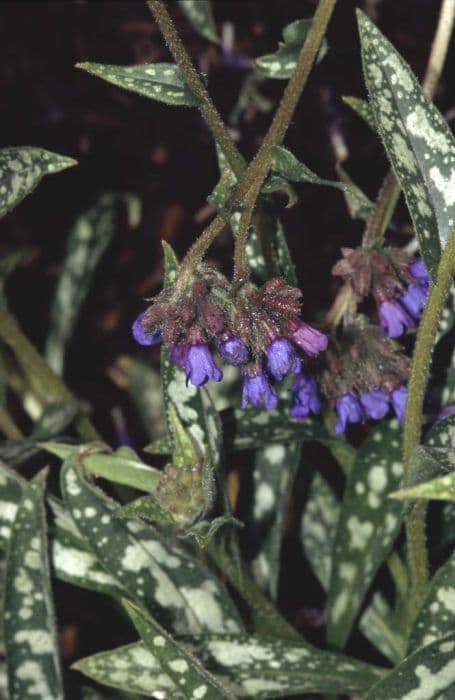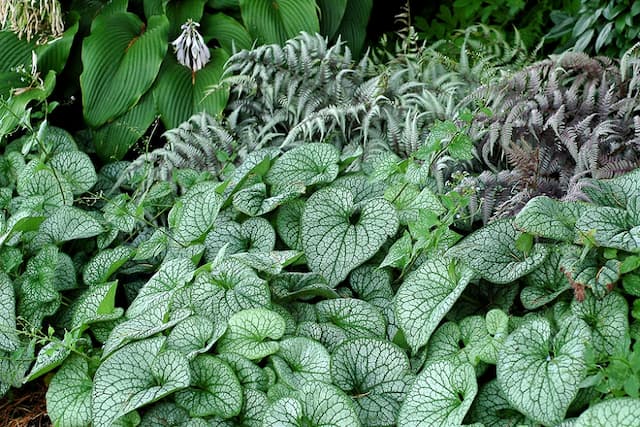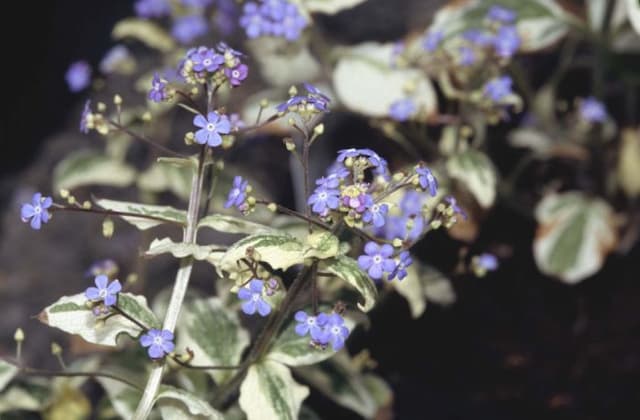Lungwort Pulmonaria longifolia 'Bertram Anderson'

ABOUT
The plant known as 'Bertram Anderson' is a type of Lungwort characterized by its eye-catching foliage and blooms. The leaves are distinctively shaped, often broadly lanceolate, and boast a unique mottling pattern of silver and green. This variegation offers a striking contrast that catches the eye and adds visual interest to shaded garden areas. As spring emerges, so do the flowers of the 'Bertram Anderson' Lungwort, which are noteworthy for their color-changing qualities. The blossoms usually begin with a pink hue and gradually transition to a vivid blue as they age. This enchanting metamorphosis provides a multicolored display that enhances the plant's allure. The texture of the Lungwort's foliage is rough to the touch due to the presence of tiny hairs on the leaves' surface. This hairy characteristic is typical of the plant, adding a tactile dimension to its aesthetic. Overall, 'Bertram Anderson' contributes both visual splendor and textural variety to any shade garden with its decorative leaves and blossoming flowers.
About this plant
 Names
NamesFamily
Boraginaceae.
Synonyms
Bertram Anderson Lungwort, Narrow-leaved Lungwort, Long-leaf Lungwort.
Common names
Pulmonaria longifolia.
 Toxicity
ToxicityTo humans
Lungwort (Pulmonaria longifolia 'Bertram Anderson') is generally considered non-toxic to humans. Ingestion of any part of the plant typically does not lead to serious poisoning. However, it is always advised to avoid eating ornamental plants due to possible individual allergic reactions or potential irritations.
To pets
Lungwort (Pulmonaria longifolia 'Bertram Anderson') is not commonly known to be toxic to pets. Cats and dogs that ingest parts of this plant are unlikely to experience serious poisoning. However, as with humans, consuming non-food plants can sometimes result in mild gastrointestinal upset such as vomiting or diarrhea for sensitive individuals or due to ingestion of large amounts.
 Characteristics
CharacteristicsLife cycle
Perennials
Foliage type
Semi-deciduous
Color of leaves
Mixed
Flower color
Blue
Height
1 foot (30 cm)
Spread
1 foot 6 inches (45 cm)
Plant type
Herb
Hardiness zones
3
Native area
Europe
Benefits
 General Benefits
General Benefits- Attracts Pollinators: Pulmonaria longifolia 'Bertram Anderson', commonly known as lungwort, is known for attracting bees and other beneficial pollinators to the garden.
- Low Maintenance: Lungwort is a hardy perennial that requires minimal upkeep once established in an appropriate location.
- Shade Tolerant: This plant thrives in shaded areas, making it a great choice for underplanting in woodland gardens or other areas where sunlight is limited.
- Early Blooming: Lungwort provides early spring flowers, offering a splash of color after the winter season when few other plants are in bloom.
- Erosion Control: The rhizomatous nature of lungwort helps to stabilize the soil, which can prevent erosion in sloped or uneven areas.
- Drought Resistant: Once established, lungwort can tolerate periods of drought, making it suitable for xeriscaping or low-water gardens.
 Medical Properties
Medical PropertiesThis plant is not used for medical purposes.
 Air-purifying Qualities
Air-purifying QualitiesThis plant is not specifically known for air purifying qualities.
 Other Uses
Other Uses- The leaves of Pulmonaria longifolia 'Bertram Anderson', commonly known as lungwort, can be used in compost as a source of nitrogen, similar to other green plant matter.
- Lungwort can be planted as part of a butterfly garden since it provides nectar for early spring pollinators when not many other flowers are in bloom.
- This plant's variegated leaves can be used to add visual interest to floral arrangements or crafts, offering a unique texture and color.
- Lungwort can serve as an indicator plant in a garden, showing signs of distress in soil moisture balance, which can aid gardeners in adjusting their watering practices.
- Its dense foliage can provide a protective ground cover for smaller creatures, such as frogs and beneficial insects, creating a microhabitat.
- The plant can be used in educational settings, such as schools or botanical gardens, to demonstrate the concept of symbiosis with mycorrhizal fungi.
- Lungwort leaves can be used to create natural dyes for fabrics or paper, with varying shades of green or brown depending on the mordant used.
- Enthusiasts of fairy gardens or miniature landscapes can utilize the textured leaves and flowers of lungwort to create a whimsical ground setting.
- The plant might be used in artistic photography, where its unique patterns and early blooms can serve as an intriguing subject in macro and nature photography.
- In colder climates, lungwort can act as an early source of groundcover, protecting the soil from late winter and early spring frost damage.
Interesting Facts
 Feng Shui
Feng ShuiThe Lungwort is not used in Feng Shui practice.
 Zodiac Sign Compitability
Zodiac Sign CompitabilityThe Lungwort is not used in astrology practice.
 Plant Symbolism
Plant Symbolism- Hope: The Pulmonaria longifolia 'Bertram Anderson', commonly known as Lungwort, is often associated with hope, as its flowers can bloom early in the spring, symbolizing the end of winter and the hope that comes with the onset of a new season.
- Healing: Traditionally, Lungwort has been used in herbal medicine, particularly for treating lung diseases, due to its lung-like patterned leaves. Its symbolism of healing stems from its historical medicinal uses.
- Longevity: With its long-lived foliage that remains attractive throughout the growing season, Lungwort is also symbolically connected to longevity and the persistence of life.
- Protection: The plant's name itself, Pulmonaria, suggests a protective quality for lungs and by extension symbolizes protection and care for health and well-being.
 Water
WaterThe common name for Pulmonaria longifolia 'Bertram Anderson' is Lungwort. Lungwort should be watered deeply when the soil's top inch feels dry to the touch, which typically happens once a week in active growth seasons like spring and fall. During hot, dry periods, watering frequency may increase, and you might need to water it two or three times a week. Use enough water to saturate the root zone, which is roughly equivalent to 1 inch of rainfall, or around 0.62 gallons per square foot. In cooler or non-growth seasons like winter, reduce the frequency to minimize the risk of root rot, watering only when the soil is dry several inches down.
 Light
LightLungwort thrives best in partial shade to light shade conditions. The ideal spot is one that receives bright, indirect light or dappled sunlight. Morning sun with afternoon shade or light penetration through a canopy of deciduous trees is perfect for Lungwort, protecting it from the harsh midday sun.
 Temperature
TemperatureLungwort prefers cool to average home temperatures, thriving between 50°F and 75°F. The minimum temperature it can withstand is around 30°F, but for optimal growth, avoid exposure to extreme cold. Ideal growth occurs when temperatures are kept consistent within the preferred range and not exposed to drastic temperature fluctuations.
 Pruning
PruningPruning Lungwort helps maintain its appearance and health. It should be pruned in late winter or early spring to remove any old, damaged leaves and to shape the plant before new growth begins. Cutting back the foliage after flowering encourages a second bloom and keeps the plant tidy. Prune Lungwort every year to promote vigorous growth and enhance air circulation.
 Cleaning
CleaningAs needed
 Soil
SoilLungwort, or Pulmonaria longifolia 'Bertram Anderson', prefers a soil mixture that is rich in organic matter, well-draining, and with a slightly acidic to neutral pH of around 6.5 to 7.0. A soil mix composed of garden loam, peat moss, and perlite or vermiculite in equal parts can create the ideal growing conditions, ensuring good moisture retention yet avoiding waterlogging.
 Repotting
RepottingLungwort doesn't require frequent repotting and can thrive in the same pot for several years. It's best to repot Lungwort every 3-4 years or when you notice that the plant has outgrown its current pot, which is evident when roots start to come out of the drainage holes.
 Humidity & Misting
Humidity & MistingLungwort prefers higher humidity levels but will tolerate average indoor humidity. Aim for a humidity level between 45% to 65% for optimal growth, which can often be achieved in a typically humid environment like a bathroom or kitchen, or through the use of a humidifier.
 Suitable locations
Suitable locationsIndoor
Provide dappled light, keep the soil moist.
Outdoor
Partial shade, rich moist soil, cool roots.
Hardiness zone
4-8 USDA
 Life cycle
Life cyclePulmonaria longifolia 'Bertram Anderson', commonly known as lungwort 'Bertram Anderson', is a herbaceous perennial plant. It begins its life as a seed, which, under suitable moisture and temperature conditions, will germinate and sprout into a seedling. The seedling develops into a rosette of leaves at the soil surface, and as it matures, it establishes a deep root system. In spring, lungwort 'Bertram Anderson' produces flowering stalks with clusters of pink to purple flowers that are popular with pollinators like bees. Following pollination, the flowers develop into small nutlet-like fruits that contain the seeds, thereby completing the reproductive stage. The plant then enters a period of dormancy in the winter months, with the foliage often dying back to the ground, before resuming growth again in the next spring.
 Propogation
PropogationPropogation time
Spring-Early Summer
Pulmonaria longifolia 'Bertram Anderson', commonly known as long-leaf lungwort, can be propagated by division, which is the most popular method for this perennial plant. The best time for division is either in the spring after flowering or in the early fall when the weather is cool, and the plant is not under heat stress. To propagate by division, carefully lift the entire plant from the ground using a garden fork, ensuring you get as much of the root system as possible. Gently shake off the excess soil and tease the clump apart into smaller sections, making sure each new piece has a portion of the roots and a few shoots. These sections can then be replanted in soil amended with compost, spacing them about 12 inches (approximately 30 centimeters) apart to allow for growth. Water the newly planted divisions well and maintain adequate moisture while they establish themselves in their new location. This method allows gardeners to rejuvenate older clumps and create additional plants to expand their garden or share with friends.









